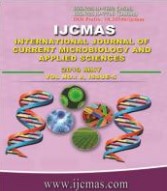


 National Academy of Agricultural Sciences (NAAS)
National Academy of Agricultural Sciences (NAAS)

|
PRINT ISSN : 2319-7692
Online ISSN : 2319-7706 Issues : 12 per year Publisher : Excellent Publishers Email : editorijcmas@gmail.com / submit@ijcmas.com Editor-in-chief: Dr.M.Prakash Index Copernicus ICV 2018: 95.39 NAAS RATING 2020: 5.38 |
India is the second largest producer of silk and also the largest consumer of silk in the world having a strong tradition bound domestic market and it has the distinction of producing all the four varieties of silk viz. Mulberry, Eri, Tasar and Muga. In India, due to favorable climatic conditions, mulberry is cultivated mainly in five states, viz., Karnataka, Andhra Pradesh, Tamil Nadu, West Bengal and Jammu & Kashmir. These five states collectively account for 97% of the total area under mulberry cultivation and 95% of raw silk production in the country. The present global scenario clearly indicates enormous opportunities for the Indian Silk Industry. In 2016-17 the mulberry Silk Production Statistics estimated the world silk production to be 192,692 metric tonnes. China’s contribution to world silk production is 80% (158,400 metric tonnes), and the share of Indian silk production is 30,348 metric tons (13%). China and India together account for 93% of world silk production. According to the Annual Report of the Central Silk Board (CSB) for the year 2016-2017 the silk scenario of India Domestic demand 36,000 metric tonnes, Own production 30,348 metric tonnes, Gap in production 6000 metric tonnes, Raw silk imports 3795 metric tonnes, Silk fabric imports 3000 metric tonnes, Silk exports (worth Rs.) 2093.42 cr, Sericulture villages 52,360, Sericulture families 9, 47, 631, Employment (lakh persons) 85.10. The market share of Indian silk exports in the global silk trade is 4% to 5%.
 |
 |
 |
 |
 |